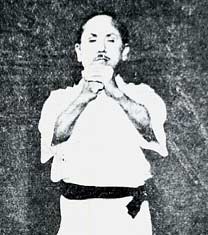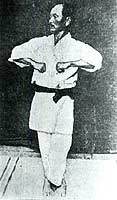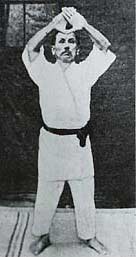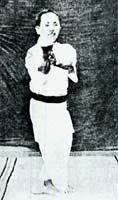Roots Of Shotokan:
Funakoshi's Original 15 Kata
Part 2 - Pinan, Naihanchi, Kushanku & Passai Kata
by Joe Swift

Editor's Note: This three part series examines
the roots of Shotokan karate through Gichin Funakoshi's 15 original
kata. The first
article discussed the controversy over Funakoshi's classification
of Okinawan karate's Shorin and Shorei traditions by body type, as well
as his knowledge of kata. The following two articles focus on in-depth
discussions of the meaning and origin of Funakoshi's core kata.
The Original Fifteen Kata of Shoto: The First Ten
Pinan (Heian) 1-5
| |
| Funakoshi demonstrating pinan
two (nidan) |
The Pinan series is commonly accepted as being created by Anko Itosu
(one of Funakoshi's teachers). The only real controversy is whether
he created them based upon his knowledge of the classical kata such
as Kushanku and Passai, or whether he was reworking a unique Chinese
form called Channan. Others historians suggest the Channan kata were
originally Itosu's creations but were changed.
There has also been argument recently about whether Itosu had created
them as an adjunct to physical education, or whether he was trying to
establish a separate tradition to further distinguish his modern karate
tradition from Quanfa (fist techniques), or Toudi (Chinese Hand, also
alternately pronounced as karate) -- both referring to older style fighting
and self-defense traditions. In either case, the Pinan can be considered
representative of Itosu's karate. The Pinan kata are said to have been
officially introduced in the spring of 1904 (Gima et al, 1986).
Although there is some opposition to the idea Itosu had developed these
kata, most of the primary sources, including those by Itosu's students,
point to Itosu as the architect of this tradition. Choki Motobu, in
both his 1926 and 1932 publications, states:
"The Pinan were created by the modern Bujin (warrior) Itosu Sensei
as teaching materials for his students, making them truly a unique form
of Okinawan kenpo, which is indeed a very joyous thing for those who
follow the Way" (Motobu, 1926, 1932).
In their early, formative years, these kata seem to have been called
Channan, but later the name Pinan was adopted by Itosu, apparently upon
hearing the opinions of the young students (Kinjo, 1956a; Mabuni et
al, 1938; Murakami, 1991; Swift, 2000). Apparently, many of those who
learned the Pinan kata as Channan continued to teach them under that
name (Mabuni et al, 1938).
In contrast, another theory states that Itosu did not create the Pinan
kata, but actually remodeled older Chinese-based kata called Channan.
This theory maintains that Itosu learned a series of Chinese Quan-fa
xing/kata (kung fu) from a shipwrecked Chinese person at Tomari (a small
seaport town on Okinawa), and reworked them into five smaller components,
re-naming them Pinan because the Chinese pronunciation "Chiang-Nan"
was too difficult (Bishop, 1999).
An interesting side note on the Pinan kata is provided by the Okinawan
karate authority Hiroshi Kinjo. He states that Hisateru Miyagi (a former
student of Itosu who graduated from the Okinawa Prefectural Normal School
in 1916) said that when he (Miyagi) was studying under the old master,
Itosu only really taught the first three Pinan with any real enthusiasm,
and that the last two were rather neglected (Kinjo, 1956b).
Naihanchi (Tekki) 1-3
The Naihanchi, a.k.a. Naifuanchi (here demonstrated by Funakoshi in
his 1924 book), series is said to be typical of in-fighting techniques,
including grappling.  There
are three kata in modern (i.e. post 1900) karate, with the second and
third thought to have been created by Anko Itosu (Iwai, 1992; Kinjo,
1991a; Murakami, 1991). Another popular theory is that originally the
three were one kata, but were broken up into three separate parts by
Itosu (Aragaki, 2000; Iwai, 1992). More research is necessary to prove
or dispute either theory.
There
are three kata in modern (i.e. post 1900) karate, with the second and
third thought to have been created by Anko Itosu (Iwai, 1992; Kinjo,
1991a; Murakami, 1991). Another popular theory is that originally the
three were one kata, but were broken up into three separate parts by
Itosu (Aragaki, 2000; Iwai, 1992). More research is necessary to prove
or dispute either theory.
This kata (as some have suggested) was not originally developed to
be used when fighting against a wall, but could be used for this purpose.
While the kata itself linear, moving side to side, the applications
are more often than not against an attacker who is in front of you,
or grabbing at you from the sides or behind. Some say that the side-to-side
movement is to build the necessary balance and physique for quick footwork
and body-shifting (Kinjo, 1991b).
Itosu was considered to have mastered the original Naifuanchi (Aragaki,
2000; Nihon Karate Kenkyukai, 1955). It is also thought that changed
the original kata. Kenwa Mabuni (1889-1941), a direct student of Itosu
and founder of Shito-ryu karate-do, supposedly learned the Naifuanchi
kata from an old expert named Seihaku Matayoshi. Upon showing this kata
to Itosu, Mabuni was told that the way he performed it was the old way,
and that Itosu had researched and improved the kata, so Mabuni should
practice it the new way instead (Iwai, 1992, 2000).
So important was the Naifuanchi kata to old-style karate that Kentsu
Yabu, the martial arts instructor at the Okinawa Prefectural Teacher's
School, often told his students "Kata wa Naifuanchi ni hajimari,
Naifuanchi ni owaru" (Kata begins and ends with Naifuanchi) (Gima
et al, 1986). Yabu often admonished his students that one must practice
the kata 10,000 times in order to make it one's own. Even Funakoshi
recalled in his autobiography that he spent a total of ten years learning
and practicing the three Naihanchi kata while studying under Itosu (Funakoshi,
1956).
As far as the origins of Naifuanchi are concerned, there are several
theories, but unfortunately little if any evidence to corroborate or
disprove them. The oldest written references to Naifuanchi's history
are probably in the books of the renowned fighter Choki Motobu. Motobu
stated in his two books, "Okinawa Kenpo Toudijutsu Kumite-hen"
and "Watashi no Toudijutsu" that Naifuanchi was imported from
China, but is no longer practiced there (Motobu, 1926, 1932). Unfortunately,
this author is unable to confirm whether or not Naifuanchi is still
practiced in China.
Noted Okinawan karate historian Akio Kinjo relates his own experience
in researching the roots of Naifuanchi. In the 1960s, he sought out
Danchi Kaneko, who had studied a Taiwanese form of White Crane boxing
known as Ban Qiu Ban Bai He Quan (lit. Half Hillock, Half White Crane
Boxing). Kaneko, an acupuncturist who lived in Yonabaru, taught a form
that would be pronounced Neixi (lit. Inside-Knee) in Mandarin Chinese,
which includes the same sweeping action found in the Nami-gaeshi or
returning wave technique of the Okinawan Naifuanchi kata. This technique
is shown below, as demonstrated by Motobu in his 1926 book.
The "returning wave" (the term actually coined by Funakoshi
to explain an Okinwan technique to the Japanese), involves sweeping
the sole of one foot up to the thigh of the other leg. Some have alternately
interpreted this move to be a block of a kick, avoiding a sweep, a stomping
down, or kick to an opponent's leg.
Kinjo also states that subsequent research in Fujian revealed to him
that Neixi is pronounced "Nohanchi" in the Fuzhou dialect.
From this, Kinjo feels that Neixi is the forerunner of the modern Okinawan
Naifuanchi kata. (Kinjo, 1999)
However, even with this speculation, many questions remain unanswered
with regard to the origins of this important kata.
Kushanku (Kanku)
 |
| Funakoshi demonstrating the
first move of Kusanku (Kanku) kata |
Described by some as a "night fighting kata," no references
to night fighting are found in the primary references coming out of
Japan and Okinawa, leading this author to conclude that such interpretations
were contrived to fit movements of this classical kata that are not
very well understood.
In the year 1762, a tribute ship sent to Satsuma (the Japanese clan
based in Japan's most southern island, Kyushu) from the Ryukyus (the
island chain in which Okinawa is the principle island) was blown off
course during a storm and landed at Tosa Province (named after the Tosa
clan) on Shikoku island, where they remained for a month.
The Confucian scholar of Tosa, Ryoen Tobe (1713-1795), was petitioned
to collect testimony from the crew. The record of this testimony is
known as the "Oshima Hikki" (literally "Note of Oshima",
the name of the area of Tosa where the ship ran aground). In this book,
there is some very provocative testimony by a certain Shionja Peichin,
describing a man from China called Koshankin, who demonstrated a grappling
technique (McCarthy, 1995; Murakami, 1990; Sakagami, 1978).
It is commonly accepted that Koshankin was the originator of the Okinawan
Kusanku kata (Kanku), or at least inspired it. However, there are several
unknowns in this equation. First of all, was Koshankin his name or a
title, or even a term of affection? Second, if it was a title or term
of affection, what was his real name? Third, what martial art(s) did
he teach, and how do they differ from the modern karate kata of Kusanku?
Most of these questions are still being researched by this author and
others.
For now, suffice it to say that Kusanku is a highly important kata
in the Okinawan martial arts, and has spawned many versions over the
years. While there are numerous others, some of main kusanku versions
include:
-
Kusanku Dai/Sho of Anko Itosu lineage styles
-
Chibana no Kusanku of Shudokan
-
Takemura no Kusanku of Bugeikan and Genseiryu
-
Kanku Dai/Sho of Shotokan
-
Shiho Kusanku of Shito-ryu
-
Yara no Kusanku of Chotoku Kyan lineage styles
Although it is said that Funakoshi learned Kushanku from Anko Asato,
after a careful comparative analysis it is my belief that he in fact
learned it from Itosu (as Kushanku Dai that Itosu had re-worked for
his physical education curriculum). More research is necessary, however.
Kanku Dai (the modern Shotokan version of the Itosu Kushanku Dai kata)
is one of two standardized Shotokan forms designated by the Japan Karatedo
Federation (JKF) for kata competitions.
Passai (Bassai)
 The
Passai kata has perhaps spawned the greatest number of confirmed versions
than any other kata in the Okinawan self-defense traditions. Although
the roots of this kata are obscure, there are several theories as to
its history.
The
Passai kata has perhaps spawned the greatest number of confirmed versions
than any other kata in the Okinawan self-defense traditions. Although
the roots of this kata are obscure, there are several theories as to
its history.
Okinawan karate researcher Akio Kinjo feels that the Passai kata is
related to Leopard and Lion boxing forms (Kinjo, 1999). He believes
that the first step in the kata, where one steps in, twists the body
sideways and performs a strong strike/block with the closed fist (here
demonstrated by Funakoshi in his 1924 book), is representative of Leopard
boxing, whereas the use of the open hand and the stomping actions are
more representative of Lion boxing. The name itself, Kinjo holds, actually
means "Leopard-Lion," which would be pronounced "Baoshi"
in Mandarin, "Baassai" in Fuzhou dialect and "Pausai"
in Quanzhou dialect (Kinjo, 1999).
Other theories as to the original meaning of the name Passai include
"eight fortresses" (Bishop, 1999). Noted Okinawan karate historian
Tetsuhiro Hokama has even hypothesized that it might represent a personal
name (Hokama, 1999). Katsumi Murakami, a direct student of such luminaries
as Choshin Chibana (Shorin-ryu), Motokatsu Inoue (Ryukyu Kobujutsu),
Juhatsu Kyoda (Toíon-ryu) and many others, calls upon his knowledge
of Chinese martial arts when searching for the possible roots of Passai.
He says that some parts remind him of the Wuxing Quan (Five Elements
Fist) form of Xingyi Quan (kung fu) (Murakami, 1991).
Of the Okinawan versions of Passai, a clear evolutionary link can be
seen from the "Matsumura no Passai" (named after the great
karate master Soken Matsumura c.1809-1901) to the "Oyadomari no
Passai" (named after the Tomari karate legend) and then on to the
"Passai Dai of Itosu" (Kinjo, 1978, 1991). The Matsumura version
seems to have retained an essentially Chinese flavor, whereas the Oyadomari
version is a more "Okinawanized" form, which was further modified
by Itosu into the uniquely Okinawan modern version seen today (Kinjo,
1991).
Noted Shito-ryu instructor and researcher Toshihisa Sofue discusses
the theory that Passai was developed as a lead-in to Kushanku kata,
by citing that most of the "Shuri" styles of karatedo today
teach the Pinan, Naifuanchi and Passai before entering into the study
of Kushanku (Sofue, 1999). However, he contradicts his own theory by
also citing that Passai, while containing some similarities to Kushanku,
is indeed an independent tradition, based upon the fact that it contains
several unique features that are not found in Kushanku (Sofue, 1999).
Funakoshi's Passai is clearly the Passai Dai of Itosu, which is very
similar to the Ishimine no Passai, believed to be passed down by Bushi
Ishimine (Murakami, 1991; Sakagami, 1978).
The final
part of this three article series will discuss the kata
Seisan, Wanshu, Chinto, Jitte and Jion.
About The Author:
Joe Swift, native of New York State (USA), has lived in Japan since
1994. He works as a translator/interpreter, and previously served
as an assistant instructor at the Mushinkan Okinawa Karate Kobudo
Dojo in Kanazawa. Swift now resides in Tokyo and will be opening a
a branch of the Mushinkan Dojo (Okinawa Shoreiryu) in that city. A
well know karate historian and researcher, Swift has published articles
in the Dragon Times and other leading martial arts journals and on
a variety of martial arts sites around the world. He is a Contributing
Editor for FightingArts.com.